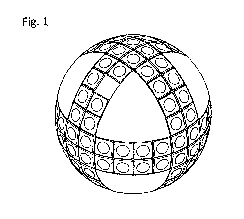Some of the information on this Web page has been provided by external sources. The Government of Canada is not responsible for the accuracy, reliability or currency of the information supplied by external sources. Users wishing to rely upon this information should consult directly with the source of the information. Content provided by external sources is not subject to official languages, privacy and accessibility requirements.
Any discrepancies in the text and image of the Claims and Abstract are due to differing posting times. Text of the Claims and Abstract are posted:
| (12) Patent Application: | (11) CA 2996878 |
|---|---|
| (54) English Title: | SPHERE PUZZLE |
| (54) French Title: | PUZZLE SPHERIQUE |
| Status: | Deemed Abandoned and Beyond the Period of Reinstatement - Pending Response to Notice of Disregarded Communication |
| (51) International Patent Classification (IPC): |
|
|---|---|
| (72) Inventors : |
|
| (73) Owners : |
|
| (71) Applicants : |
|
| (74) Agent: | ROBIC AGENCE PI S.E.C./ROBIC IP AGENCY LP |
| (74) Associate agent: | |
| (45) Issued: | |
| (86) PCT Filing Date: | 2016-09-05 |
| (87) Open to Public Inspection: | 2017-03-16 |
| Availability of licence: | N/A |
| Dedicated to the Public: | N/A |
| (25) Language of filing: | English |
| Patent Cooperation Treaty (PCT): | Yes |
|---|---|
| (86) PCT Filing Number: | PCT/GR2016/000042 |
| (87) International Publication Number: | GR2016000042 |
| (85) National Entry: | 2018-02-27 |
| (30) Application Priority Data: | ||||||
|---|---|---|---|---|---|---|
|
A Sphere puzzle having a plurality of sliding blocks (7), and a series of protrusions (14), (24) and (34), and rails (41) and (51). The sliding blocks (7) move in a double row along rings (1), (2) and (3) on tracks (11), (21) and (31) through the necks (16), (26) and (36) and under the bottom surfaces of rails (42) and (52) and stay fixed in their correct position with the help of the sliding balls (74) on dents (19), (29) and (39) of the rings (1), (2) and (3), and finally have a missing block (7) from the entire array which enables movements with a large number of combinations, in order to complete the required designs on the sphere surface. The aforementioned Sphere puzzle can be assembled by the player using the basic members (1), (21), (31), (4), (5), (6) and (7).
La présente invention concerne un puzzle sphérique comportant une pluralité de blocs coulissants (7), et une série de saillies (14), (24) et (34), et des rails (41) et (51). Les blocs coulissants (7) se déplacent dans une double rangée le long d'anneaux (1), (2) et (3) sur des pistes (11), (21) et (31) à travers des cols (16), (26) et (36) et sous les surfaces inférieures de rails (42) et (52) et restent fixés dans leur position correcte à l'aide des billes coulissantes (74) sur des creux (19), (29) et (39) des anneaux (1), (2) et (3), et présentent enfin un bloc manquant (7) sur l'ensemble total, ce qui permet de réaliser des déplacements avec un grand nombre de combinaisons en vue de réaliser les motifs requis sur la surface de la sphère. Le puzzle sphérique susmentionné peut être assemblé par le joueur à l'aide des éléments de base (1), (21), (31), (4), (5), (6) et (7).
Note: Claims are shown in the official language in which they were submitted.
Note: Descriptions are shown in the official language in which they were submitted.

2024-08-01:As part of the Next Generation Patents (NGP) transition, the Canadian Patents Database (CPD) now contains a more detailed Event History, which replicates the Event Log of our new back-office solution.
Please note that "Inactive:" events refers to events no longer in use in our new back-office solution.
For a clearer understanding of the status of the application/patent presented on this page, the site Disclaimer , as well as the definitions for Patent , Event History , Maintenance Fee and Payment History should be consulted.
| Description | Date |
|---|---|
| Application Not Reinstated by Deadline | 2020-09-08 |
| Time Limit for Reversal Expired | 2020-09-08 |
| Common Representative Appointed | 2019-10-30 |
| Common Representative Appointed | 2019-10-30 |
| Deemed Abandoned - Failure to Respond to Maintenance Fee Notice | 2019-09-05 |
| Change of Address or Method of Correspondence Request Received | 2018-12-04 |
| Inactive: Cover page published | 2018-05-22 |
| Inactive: First IPC assigned | 2018-05-14 |
| Inactive: Notice - National entry - No RFE | 2018-03-14 |
| Inactive: IPC assigned | 2018-03-09 |
| Application Received - PCT | 2018-03-09 |
| National Entry Requirements Determined Compliant | 2018-02-27 |
| Application Published (Open to Public Inspection) | 2017-03-16 |
| Abandonment Date | Reason | Reinstatement Date |
|---|---|---|
| 2019-09-05 |
The last payment was received on 2018-08-23
Note : If the full payment has not been received on or before the date indicated, a further fee may be required which may be one of the following
Patent fees are adjusted on the 1st of January every year. The amounts above are the current amounts if received by December 31 of the current year.
Please refer to the CIPO
Patent Fees
web page to see all current fee amounts.
| Fee Type | Anniversary Year | Due Date | Paid Date |
|---|---|---|---|
| Basic national fee - standard | 2018-02-27 | ||
| MF (application, 2nd anniv.) - standard | 02 | 2018-09-05 | 2018-08-23 |
Note: Records showing the ownership history in alphabetical order.
| Current Owners on Record |
|---|
| KAINOTOMIES VERDE KYVIKA LOGIKA PAIXNIDIA AEVE |
| ILIAS CHRONOPOULOS |
| ANASTASIA CHRONOPOULOU |
| KALLIOPI CHRONOPOULOU |
| Past Owners on Record |
|---|
| None |